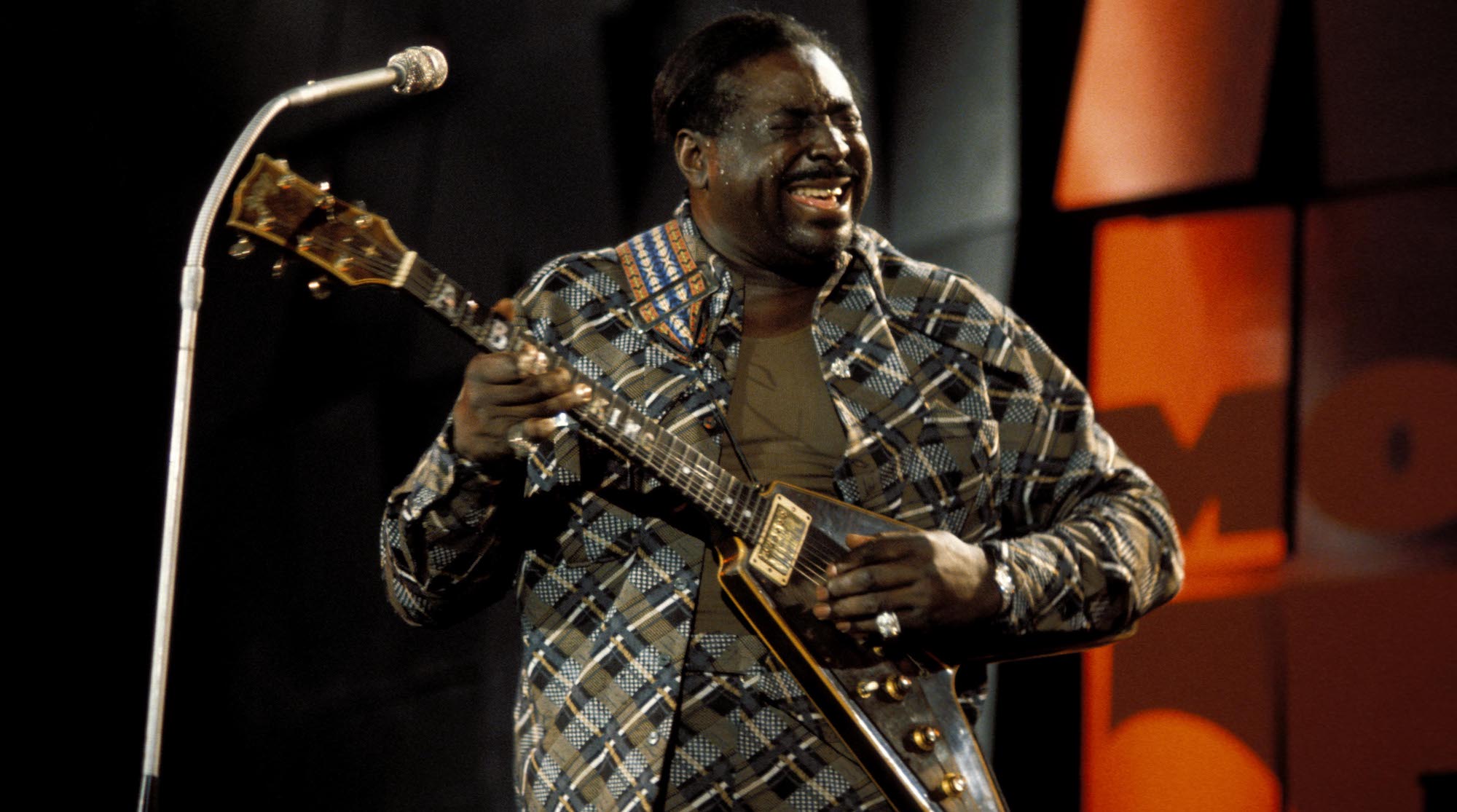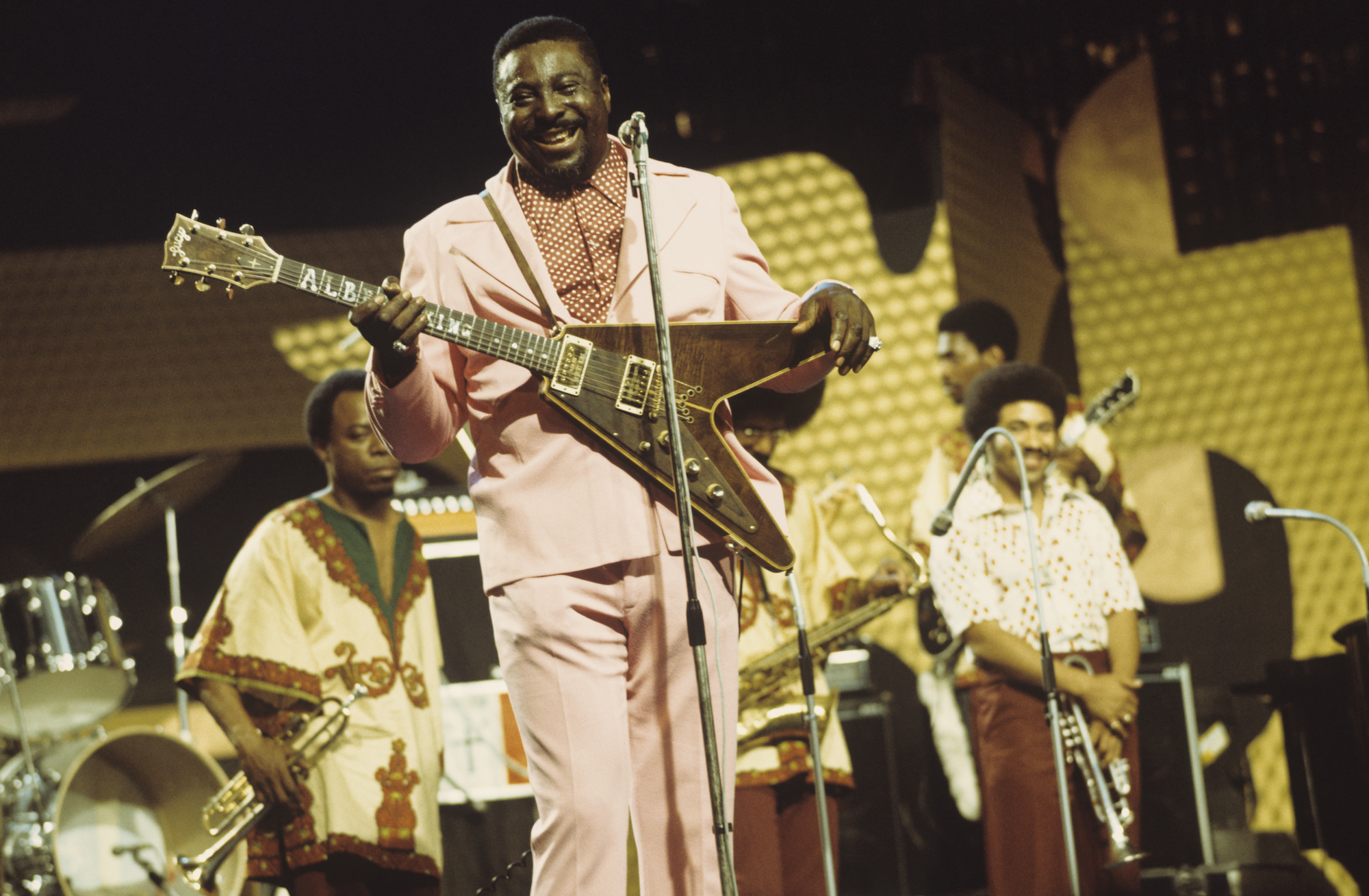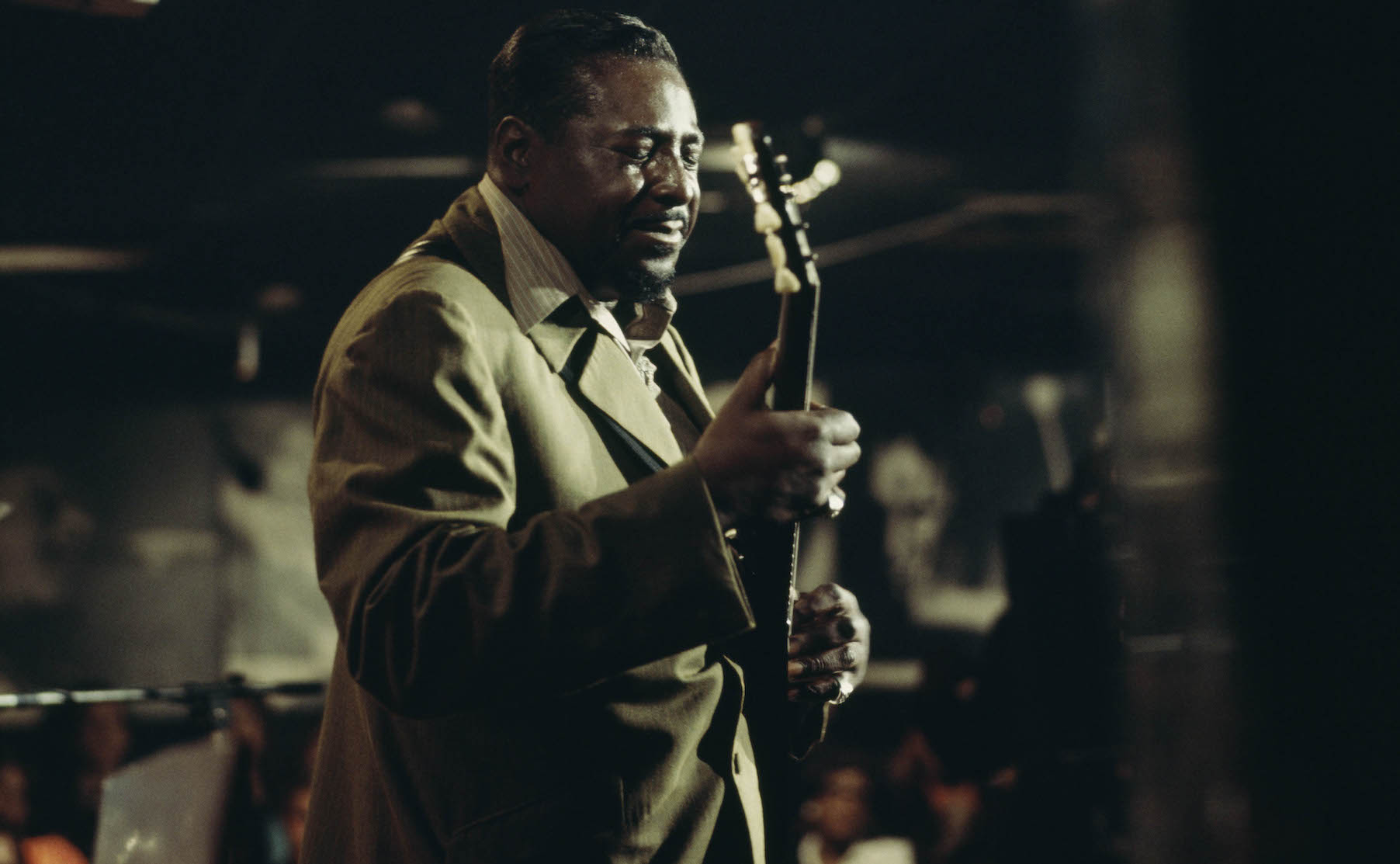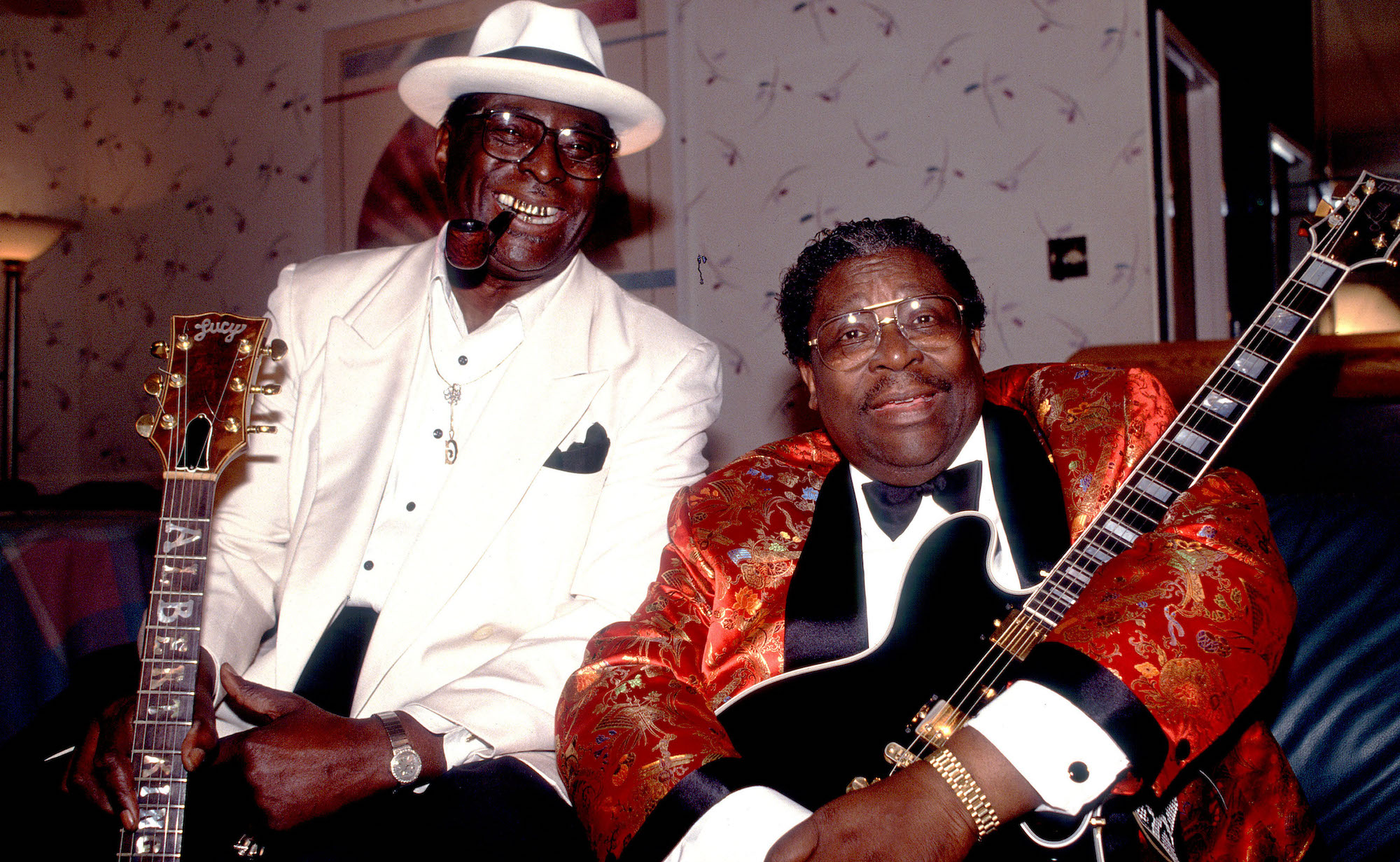
This story originally appeared in the March/April 2013 issue of Guitar Aficionado magazine.
Albert King was a giant among bluesmen, and not only for his immense talents on the guitar. A 250-pound giant of considerable bulk, King stood between six-four and six-seven and made any guitar he held in his massive hands look like a child’s plaything.
But the notes and tones he tore from the instrument were anything but small. In the middle years of the 20th century, King grabbed hold of a Gibson Flying V and boldly went where no blues guitar player had gone before, or has gone since.
A left-hander, he flipped a right-handed guitar upside down, put it in an unorthodox tuning, and forged a style steeped in steely drama and epic note-bends that evoke the vertiginous blood rush of powerful emotions.
King’s impact on the blues and rock guitar legacy is prodigious. Eric Clapton, Mike Bloomfield, Jimi Hendrix and Stevie Ray Vaughan have been among his greatest admirers. Each drafted huge chunks of King’s fiercely original style into his own playing. Clapton famously nicked the solo from King’s Oh, Pretty Woman and inserted it in Strange Brew from Cream’s wildly influential 1967 album, Disraeli Gears.
Jimi Hendrix cited King’s Crosscut Saw as one of his favorite tunes. Mike Bloomfield covered King's Don’t Throw Your Love on Me So Strong, and Cream recorded their own version of King’s signature tune, Born Under a Bad Sign. As for Stevie Ray Vaughan, he outdid his King-crazed predecessors by recording an In Session television special with his hero in 1983.
His influence on many of the world’s most revered guitarists is sufficient to make him a national treasure of American music. But in many ways, his own achievements outshine those of his acolytes. After all, he did it first. And he certainly did it his way.
True to his name, King is arguably the monarch of upside-down-lefty guitarists, a distinguished company that includes Otis Rush, Doyle Bramhall II, Elizabeth Cotten, and Coco Montoya in the blues-folk realm, and everyone from Babyface to Bob Geldof in other genres.
The barbed-wire minimalism of King’s searing leads makes an ideal counterpoint to his husky, gospel-inflected vocal style. It’s a true call-and-response passion play. King was nicknamed the Velvet Bulldozer, a name that resonates once you realize that he once made his living driving a bulldozer. Albert King lived the blues. That’s why he played and sang them so beautifully.
He had a remarkably wide perspective on the blues as well, crossbreeding more traditional 12-bar forms with everything from sweet Stax soul to big-band balladry.
Like a lot of left-hand/right-brain creatives, Albert King didn’t play by any rulebook but his own, nor would he suffer fools gladly. Possessed of a notoriously bad temper, he would lay into band members onstage if things weren’t going his way. In one famous public display of anger, he chewed out John Mayall’s Bluesbreakers, who were backing him, for playing too loud.

Luthier Dan Erlewine, who made King one of the Flying V guitars that he played throughout his career, had a few occasions to witness the Velvet Bulldozer in high dudgeon.
“The first time Albert was playing at the Grande Ballroom, I was backstage after the show,” Erlewine says, referring to Detroit’s legendary Sixties rock venue, just a few miles from the bridge to Windsor, Ontario. “And Albert was pissed at the promoters, who were trying to pay him with Canadian bills. He wouldn’t take them. ‘I don’t want none of that funny money,’ he said. And they got him what he wanted.”
King was known to pack a gun, so people were reluctant to cross him. But his hot temper was only one aspect of a complex and gifted artist. Erlewine puts the anger down to a combination of impatience and competitiveness.
“I’d say Albert was more competitive than some, certainly more so than the older folks out there, like [his blues contemporaries] Mance Lipscomb and Johnny Shines. As a person, though, Albert had a softness and kindness inside. But he kept it hidden a lot.”
Along with B.B. and Freddie, Albert King is one of the three kings of the blues, although the man born Albert Nelson was related to neither of those great bluesmen by blood. He was, however, born in B.B. King's hometown – Indianola, Mississippi – on April 25, 1923.
While he may not have literally been born under a bad sign, his birth date does put Albert King in the contentious and creative zodiacal house of Taurus. Later in life, he would assume the regal surname King as a stage name, some say in homage to B.B. King.
King's family moved to Forrest City, Arkansas, when he was eight. He spent some time as an agricultural laborer, picking cotton, but set his sights on making a life for himself in music early on. He once joked that he didn’t learn from studying any other guitarists, saying, “Everything I do is wrong.” But that isn’t strictly accurate. King also spoke often of being influenced by Lonnie Johnson, Blind Lemon Jefferson and Elmore James.
“I listened to the slide guitar of Elmore James and a couple of more people I knew way back there,” he told one interviewer. “Then along came T-Bone Walker, and that did it. So I just mixed it all together, and I couldn’t get it exactly like they had it, but I just put my own thing to it.”
It may have been the open slide-guitar tunings of players like Jefferson and James that inspired King’s own use of alternate tunings. He is mainly associated with an E minor tuning (low to high, C B E G B E). But he also tuned to the same intervals in both C# and D. He was known to use open F (low to high, C F C D A D) as well.
For guitarists accustomed to playing in standard, none of these tunings are as intuitive as, say, open G or E. But remember that Albert King was holding a right-handed electric guitar the “wrong” way around. This yields a different perspective on the instrument, one that is, in a way, more in tune with nature, with the low strings closer to the ground and the high strings nearer to the sky. But even upside down, some of King’s open tunings are mighty strange, which also accounts for the unique beauty embodied in some of his phrasing.
“I knew I was going to have to create my own style,” he told guitar journalist Dan Forte, “because I couldn’t make the changes and chords the same as a right-handed man could. I play a few chords, but not many. I always concentrated on my singing guitar sound – more of a sustained note.”

King also enjoyed what’s known as the “lefty advantage” when it comes to bending notes. With the strings’ vertical arrangement flipped, you bend notes on the critical higher-pitched strings by pulling the string downward, which is much easier than pushing upward to execute a bend.
King exploited this capacity to particularly dramatic effect, sometimes bending notes as much as four tones up. His huge hands were another factor in this aspect of his style, as was the slackness of the strings in the low-slung tunings King favored.
As if all this weren’t unconventional enough, King didn’t use a pick. He mainly used his thumb to pluck the notes. But his first finger would also sometimes come into play in helping shape the steely pinched tones that are another hallmark of his style.
“I never could hold a pick in my hand,” King explained to Forte. “I had started out playing with one, but I’d be really gettin’ into it, and after a while the pick would sail across the room. I said, ‘To hell with this.’ So I just play with the meat of the thumb.”
The core elements of King’s riveting style are all evident, albeit embryonically, on his first recording, Bad Luck Blues, recorded in Chicago in 1953 for Parrot Records.
By the time he cut this disc, King had paid plenty of dues, singing lead tenor with gospel quartet the Harmony Kings, fronting his own group – the Groove Boys – in Osceola, Arkansas, and playing drums for seminal blues guitarist and singer Jimmy Reed. But Bad Luck Blues lived up to its name by not providing King with the hit he might have been hoping for.
King didn’t score big until eight years later, when he released Don’t Throw Your Love on Me So Strong in 1961. The record climbed to Number 14 on the R&B charts and put him on the map. It also became a featured track on his very first album, The Big Blues, in 1962.
A study in pinched, plucked passion, the lead guitar intro to Don’t Throw Your Love on Me So Strong makes it clear from the start that Albert King ain’t about to do things in a small way.
This is the lowdown slow blues at its finest, and the guitar-and-vocal interplay is exquisite. King’s biting leads alternate with a vocal performance that scales the full emotional range, from a mournful croon to a high-pitched gospel wail. The symbiotic relationship between King’s guitar and voice is one of the blues’ greatest treasures.
By the time the disc was released, King had found his instrument: a 1958 korina wood Gibson Flying V. There has been much speculation as to why he favored this particular guitar, but upside-down lefties tend to seek out instruments with symmetrically shaped bodies and headstocks, as they look much less awkward when flipped. And among symmetrically shaped guitars, a Flying V certainly has far more flash and panache than, say, an SG or 335.
Along with Lonnie Mack, King was one of the earliest guitarists to popularize Gibson’s angular, V-shaped masterpiece.

Like many archetypal bluesmen, King was often on the move, particularly in the early phases of his career. By 1966, he was down in Memphis and had been signed to Stax, the premier mid-Sixties R&B label, then riding high with hits by Otis Redding, Sam & Dave, Rufus Thomas, Carla Thomas, Eddie Floyd, and Wilson Pickett.
The marriage of King’s 12-bar blues with the funky Stax backbeat is a true revelation on his 1967 hit, Born Under a Bad Sign. On it, he is supported solidly by Booker T. & the MGs and the Memphis Horns as well as Isaac Hayes, whose piano vamp sets the groove strutting at a pimp-crawlin’ pace.
The deep, dark Memphis Horns reinforce the driving bass line, and funky off-beats walk up to the V chord. King’s guitar sounds crisper and more incisive than ever, his voice plumbing the desperate depths of this ultimate hard-luck narrative.
Stax had one of the greatest-sounding recording rooms of the period as well as a brilliant pool of staff musicians, producers and tunesmiths, including Hayes and Booker T. & the MGs – consisting of organist Booker T. Jones, guitarist Steve Cropper, bassist Duck Dunn, and drummer Al Jackson Jr.
It was at Stax that King’s maverick talent found an ideal home. His Stax years yielded the lion’s share of his signature recordings, including Laundromat Blues, Crosscut Saw, Personal Manager, and As the Years Go Passing By, all of which were collected on King’s first album for Stax, also titled Born Under a Bad Sign.
This was a new sound in the blues – urgently contemporary, no mere exercise in the kind of purist reconstructionism that had come into vogue at the time. The Stax tracks helped King cross over to a wider audience than he’d ever reached before.
By this point, his original 1958 Flying V had gone missing, allegedly lost by the guitarist in a game of craps. It was replaced by a 1966 Flying V presented to King by Gibson. This instrument accompanied the guitarist onto the stage for his many appearances at Bill Graham’s legendary Fillmore venues in San Francisco and New York City.
These shows found King sharing bills with rock and blues titans like Jimi Hendrix, Janis Joplin, the Byrds, the Allman Brothers Band, Van Morrison and B.B. King. After years of hard work, Albert King found an appreciative audience among the era’s blues-crazed rock fans.
One of these incendiary Fillmore nights was captured on King’s seminal live album Live Wire/Blues Power. In many ways, King is best understood through his live recordings. The spontaneity and uninhibited abandon of live performance, as compared with studio recordings, seemed particularly suited to the man’s blues muse.
But one aspect of King’s work that typically drew a puzzled response from his new young fans was his love of schmaltzy balladry. His cover of the American songbook standard The Very Thought of You that closes Born Under a Bad Sign was easily the disc’s most frequently skipped-over track. It probably still is, for that matter. But King refused to conform to anyone’s notion of what he, or the blues, should be.

In 1969, he performed with the St. Louis Symphony Orchestra. Why shouldn’t a bluesman have full symphonic backing? Albert King was the first to go there. And why shouldn’t a bluesman record an album of Elvis Presley covers, should the mood take him? King went there too with 1970’s Blues for Elvis: King Does the King’s Things.
In the early Seventies, King acquired his third iconic Flying V, the instrument custom-built by Dan Erlewine. This was his only truly left-handed guitar, with the tone controls and output jack on what would be the lower bout for King. With his previous, flipped-over right-handed Vs, the volume tone controls were awkwardly located on the upper bout.
Erlewine recalls King mentioning that it was annoying for him to reach up to adjust his tone or volume. “That was one of the reasons he wanted a lefty,” he explains. “He also wanted his name on the fretboard in pearl and abalone, so it would flash under the lights.”
Fashioned from a 125-year-old piece of black walnut, this guitar would be King’s main ax from 1972 until his passing, 20 years later. '72 was an especially good year for King, witnessing the release of another landmark recording, I’ll Play the Blues for You, a soulful minor-key outing much in the vein of B.B. King’s The Thrill Is Gone.
On I’ll Play the Blues for You – both the song and entire album of the same name – King is backed by members of two other great Stax outfits, the Bar-Kays and Isaac Hayes’ backing group, the Movement.
King stuck with Stax throughout the company’s decline in the early Seventies, moving on to several other labels after the company went bankrupt in 1975.
His Seventies recordings didn’t have quite the same impact as his Sixties work, although there are some fine tracks to be discovered among the 10 or so albums that King released between 1970 and 1978. And while King remained active as a recording and touring artist throughout the Seventies, he began to slow down in the Eighties, moving into semiretirement from the studio but continuing to play select festivals and other live dates.
Constant touring under far less than five-star circumstances was one of the things said to exacerbate the guitarist’s irritability and bad temper. But one very important gig he was able to perform – and which seemed to put him in quite a good mood – was a 1983 date with Stevie Ray Vaughan for the Canadian music television series In Session.
It is a true passing-the-torch moment, two guitar legends from very different generations seated comfortably side by side and trading licks on blues standards and some of their own most-loved tracks. Vaughan’s admiration for his six-string idol is palpable, and King really shines in this welcoming environment. The DVD document of the performance is highly recommended.
Fortunately, and unlike many of his peers, King lived to see his work embraced by several generations of blues and rock guitarists. How much this meant to the irascible bluesman is hard to say.
At times he seemed more interested in going fishing and smoking his pipe, two of his favorite leisure-time pursuits. But he was a road warrior to the last: Albert King died of a heart attack on December 21, 1992, at age 69. He’d played his last show two days earlier, in Los Angeles.

It was fitting that the Memphis Horns, who had backed King on some of his greatest musical triumphs, accompanied his body on its journey down Beale Street and across the Mississippi River to King’s final resting place in Edmondson, Arkansas.
They played When the Saints Go Marching In. One likes to think that SRV, Hendrix, Bloomfield and many of King's other gone-beyond acolytes were lined up to greet him at the Pearly Gates – or whatever serves as the musicians’ entrance to heaven.







